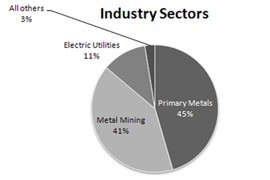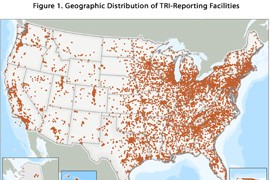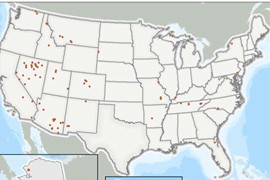Cronkite News has moved to a new home at cronkitenews.azpbs.org. Use this site to search archives from 2011 to May 2015. You can search the new site for current stories.
As Arizona mining increases, mine-related toxic releases grow
WASHINGTON – Arizona’s metal mining and manufacturing industries produced about 84.5 million pounds of toxic chemicals in 2011, a nearly 34 million pound increase from just two years earlier, the Environmental Protection Agency reported.
The EPA’s Toxics Release Inventory said Arizona mirrored a national increase in toxic releases by mining operations, which jumped 46 percent nationally from 2009 to 2011, compared with a 3 percent increase from 2003 to 2009.
“In the last few years, increases in disposal or other releases have been driven mainly by increases in land disposal at metal mines, which typically handle large volumes of material,” the report said.
Officials on both sides of the issue said the increase is not surprising in Arizona given the state’s recent boom in mining activity.
But while environmentalists said the numbers point to a need for closer regulation, mining officials called the statistics needlessly frightening. They said that what the EPA calls a toxic-release increase is really just miners moving around more of “what Mother Nature put there.”
Metal mining and processing wastes made up 86 percent of all toxins reported in Arizona in 2011, the most recent year for which numbers are available. Electric utilities accounted for 11 percent and the remaining 3 percent was attributed to miscellaneous sources, said the January report.
An EPA official pointed to a recent boom in mining activity and to naturally occurring changes in the chemical makeup of ore as possible reasons for the increase in toxic releases.
Most of the state’s releases were linked to copper: All the Arizona mines in the Toxics Release Inventory report extracted copper ore in 2011, and more than 99 percent of manufacturing releases that year were from copper processing. Arizona accounted for more than $8 billion of the nation’s $9 billion in copper production in 2012, and growth is expected to continue.
But one state official cautioned against reading too much into the report, saying that while the numbers are accurate the suggestion that mining companies are releasing chemicals in the environment is misleading.
“We feel this reporting is biased and unfair. It’s not like these mines are taking this stuff and dumping it in a river,” said Nyal Niemuth, chief of economic geology for the Arizona Department of Mines and Mineral Resources.
That was echoed by Tom Aldrich, vice president of environmental affairs Asarco, a copper mining company with a smelter in Hayden.
“What you’re moving is what Mother Nature put there,” Aldrich said.
“If the price goes up, you try to maximize production,” Aldrich said. “We’re moving vast amounts of material to get to the copper that you need.”
He said Asarco’s Hayden mine moves about 100 semi trucks of copper ore each day. With that much being moved and processed, the releases “can look rather large,” he said.
The waste from copper mining, smelting and refining comes in the form of tailings piles, slag and fumes. The EPA says that tailings piles and slag can slowly leach mineral compounds, including trace amounts of uranium, and sulfuric acid, while dust and gases released by smelter smokestacks can also be a concern.
But Niemuth said the industry has come a long way and is now much more responsible about its environmental impact than it once was.
Most Arizona mines simply move waste from one end of the mining area to the other and never release it beyond their facilities. Niemuth said mines take pains to divert water used for mining away from natural waterways, and many chemicals used to separate waste rock are saved during smelting and recycled.
Although groundwater can be an issue, new technologies and practices are decreasing the risk, he said, and companies are reclaiming some depleted mines to restore the area to its natural state.
But Bill Carter, whose book “Boom, Bust, Boom” examined the need for copper and its environmental impacts, said toxins that leach into the groundwater from mining operations never go away.
“Over time, all the plants that are growing on those manmade hills will eventually die because the roots will reach the old tailings piles,” Carter said of the reclamation process.
“The mountain stays there and bleeds incredible amounts of toxic metals into watersheds,” he said. “There’s no way to stop the bleeding.”
Carter was inspired to investigate the mining industry after falling ill from food he had grown near his Bisbee home. Despite the dangers associated with copper mining, he recognizes the need for it.
All agree copper mining will continue, if not increase. The U.S. Geological Survey’s 2013 Mineral Commodity Summaries report predicts a nationwide 10 percent increase in copper mining and production this year alone.
Niemuth said the increased demand for electronics and alternative energy, two industries that require a lot of copper, has helped drive up business for Arizona mines.
“Technology advances, and as we go forward, society needs and demands these materials,” Niemuth said.
Arizona mining will continue to grow as long as metals are needed, he said.
Carter agreed that the desire for “green” energy drives copper demand. But he said there should be more regulation on mining practices and production levels.
“If you’re anti-mining, you’re a hypocrite,” Carter said. “At some point we are going to say, ‘We need mining, but we very much also do need water and food.’”
Sandy Bahr, director of the Sierra Club’s Grand Canyon chapter, agreed that mining is necessary, but said she is concerned with its environmental impacts.
Besides toxic releases, she said, mines’ heavy use of water could “de-water” an area, a real concern in Arizona. That’s why the Sierra Club pushes for legislation to reduce pollution and hold mines accountable, she said.
“Nobody is saying we aren’t going to have mines, but where they are and how it’s done … not every place that has metals should be mined,” Bahr said.










